M.V. Clark's Blog, page 7
December 12, 2017
The Splits Zombies: The Voice from the Street
We are pleased to add some rare archive material today of a genuine vox pop about the Splits epidemic filmed on the streets of Brighton. More to come.
December 11, 2017
Title Fright - Train to Busan versus World War Z
SPOILER ALERT!
Today's Title Fright pits World War Z (2013) against Train to Busan (2016).
World War Z is a big budget zombie film directed by Marc Forster. It stars Brad Pitt as a former UN inspector and family man Gerry. When a zombie plague sweeps the world Gerry must comes out of retirement and go on one last mission to find a cure.
Train to Busan is a low budget South Korean zombie movie directed by Yeon Sang-ho. It stars Gong Yoo as distracted father Seok-Woo, and Kim Soo-Ahn as his daughter Soo-An. She persuades him to take her on a fast train to Busan to see her mother, but on the way the train is attacked by zombies.
THE WEIGH IN
Let’s compare the films to establish if they’re a good match.
I initially intended to pair Train to Busan with La Horde – a French zombie film where the battle takes place in a tower block - because both are action-horrors where the action is shaped by particular physical structures. But after watching Train to Busan I changed my mind.
Despite it’s kinetic energy, La Horde’s characters are shallow and unlikeable. They also fail to learn – notoriously, they keep shooting zombies in the chest.
Whereas Train to Busan is crammed with simple but compelling characters whose interactions keep us emotionally invested and drive the plot forwards.
It just wouldn’t be a fair fight.
Next, I decided to make Train to Busan fight 28 Weeks Later. This was excitingly close and I’d like to return to this particular match later.
But then I asked twitter and the verdict was that Train to Busan should actually be fighting World War Z.
I was skeptical at first, but after watching World War Z again I realised there were lots of interesting parallels between the two films. So here goes.
Parallel 1 - fast, organised zombies
Both films feature fast zombies which form mobs, human bridges and the like. In World War Z we see zombies get up a 20 metre wall by climbing over each other. In Train to Busan the train is almost stopped by a massive chain of zombies clinging to it.
Parellel 2 – family
In both films, the lead character is a father, and both films gain their tension from the centrality of the family.
World War Z begins with a Gerry making pancakes for his kids’ breakfast, but this idyll is ripped apart by the zombie plague. Gerry is forced to accept a mission to find a cure because otherwise his family will lose military protection.
In Train to Busan, a good fifteen minutes is devoted to establishing Seok-Yoo’s terrible relationship with his daughter. This relationship remains key throughout the film.
Parallel 3 - politics
Both films reference a wider political canvas. World War Z puts zombies in a geopolitical context, with nations making and breaking their fate according to their histories and their relationships with other nations.
Train to Busan is one big economic critique, with wealthy Seok-Yoo bent on saving his own skin while blue-collar Sang-Hwa risks his life to save others.
LET THE FRIGHT BEGIN
Let’s get them in the ring!
Round 1 - the father
To begin with, high flying finance executive Seok-Woo is a textbook terrible father. He has his secretary buy a gift for his daughter and it turns out to be the same gift he got her last time. He doesn’t turn up to her school show. It’s her birthday the next day and unsurprisingly she wants to spend it with her mother. With great irritation he agrees to take her, and that’s how they end up on the train to Busan.

Shut out - Train to Busan's Sung-Gyeong and Sung-Hwa, played by Jung Yu-Mi and Ma Dong-Seok.
When the zombies arrive on the train Seok-Woo’s first reaction is to shut out the living along with the healthy. In this case it’s uninfected couple Sung-Gyeung and Sang Hwa, played by Jung Yu-Mi and Ma Dong-Seok. Seok-Woo’s actions are even more shocking because Sung Gyeung is pregnant. Soo-An is horrified and comments on her father’s ruthlessness.
But when Sang-Hwa saves Soo-An’s life, Seok-Woo begins to reassess.
By the end of the film Seok-Woo’s completely changed his moral code. When he’s infected he throws himself off the train to save not just his daughter’s life but that of Sung-Gyeong, the pregnant woman.
In World War Z, on the other hand, Gerry doesn’t need to address his moral code. Instead of changing he thinks, gradually piecing together a way to keep healthy people safe from the undead.
Gerry’s family is happy and he’s a natural hero. “What is that Gerry?” screams his wife when the zombies attack, and she clings to his neck as he saves her.

A natural hero - World War Z's Gerry, played by Brad Pitt.
The actual devastation is far more epic than in Train to Busan, but it never gets inside Gerry. Unlike Seok-Woo, he never has to fight himself. The patriarchy is solid, the father is reliable. He doesn’t undergo an emotional journey – instead he endures a series of escalating scares whilst solving the puzzle of how to save humanity.
I call this round for Train to Busan. I love World War Z but Seok-Yoo’s journey is moving and memorable in a way that Gerry’s heroics aren’t.
Round 2 – leadership and politics
There’s a wider question in both films about how we lead society and civilisation in a time of threat.
In World War Z we encounter typically pragmatic military leadership. A navy captain played by David Andrews leaves Gerry in no doubt that his family can only stay in the safe zone if he accepts a mission.
Whereas Thierry, the UN deputy general secretary played by Fana Mokoena, protects Gerry and his family. He very reluctantly ships Gerry’s wife and children out of the safe haven – to another slightly less safe haven – when he thinks Gerry is dead.
Thierry represents global leadership and embodies another kind of pragmatism – the coming together of nations to fight a common enemy.
This is a very diluted version of the message of the novel World War Z by Max Brooks, which is a gripping but impersonal education in geopolitics. Still, the film gets across the way the rules would change in the event of global apocalypse. Even bitter enemies would be forced to work together to survive.
However, this isn’t exactly political. I’m indebted here to a blog by The Political Omnivore. You should absolutely check out this brilliant blogger if you haven’t already.
The Political Omnivore says that there are no politics in World War Z. The zombies are neither left-wing nor right-wing. They’re not a commentary on how we run our societies. They’re a metaphor for apocalypse. The closest World War Z gets to a political message is that in such circumstances we must drop politics.
Whereas Train to Busan dives headlong into hot political waters. For example, Seok-Woo’s ruthless moral code is explicitly linked to his position in society. When he tells another character he’s a fund manager, he’s told he’s a leech.
His selfish behaviour is contrasted with the heroics of working-class Sung-Hwa, who sacrifices himself for the greater good.
Another passenger, wealthy chief executive Yong-Suk – played by Kim Eui-Sung - is even worse. Seok-Woo changes, but Yong-Suk remains committed to his ‘I’m alright Jack’ mentality until his death. The staff on the train cravenly follow his lead.
Parallels are drawn between zombies and the living, and at times the two are virtually indistinguishable. For example when Yong-Suk and his coterie bay at Seok-Woo and his survivors to leave the one carriage that remains safe because they may be infected.
It’s been suggested that this is a comment on South Korea’s worst ever maritime disaster, when a ferry sank killing 300 people, mostly children. The ferry had been overloaded for commercial reasons, and crew fled after telling passengers to stay put.
I’d call this round a draw. World War Z looks to the future and is a genuinely original take on the zombie flick. Train to Busan covers familiar ground for a zombie narrative – left-leaning class conflict – but the relevance of this cannot be denied.
Round 3 – pace and structure
World War Z is confused.
We all know the story of how the final third got re-shot. Initially the final act was set in a remote yet high-profile nation state. After South Korea and Israel, Gerry was to go to Russia and die in battle. It didn’t work and another ending was put together where Gerry ends up at a World Health Organisation facility in Wales.
In a virtually action-free sequence of high suspense, he discovers a way to make humans invisible to zombies. He injects himself with a lethal bacteria that makes the undead ignore him because they only want to pass the virus to healthy hosts.
This is a great piece of cinema but it leaves a slightly odd taste in the mouth. The switch from geopolitics to microbiology is somewhat vertiginous and every time I watch it I get motion sickness.
Train to Busan, in contrast, is perfectly structured. The relationship between Seok-Woo and Soo-Ann drives the action throughout the film, there’s no sudden lurch into to what is almost a totally different genre.
At the end, Seok-Woo is bitten trying to protect Soo-An from the infected Yong-Suk. He succeeds in throwing Yong-Suk from the train and then has about a minute to spend with his daughter before he turns. He shows her how to stop the train and tells her that he loves her, but then he has to go. If you aren’t moved you must have a heart of stone.
This scene is the perfect culmination of what has come before. Through it, the film links the health of our intimate relationships with the health of wider society.
I call this round for Train to Busan. World War Z has a brilliant energy that compensates for its flaws. Whereas Train to Busan is simply flawless.
BEATEN ON POINTS
Train to Busan wins on points.
World War Z is more original and ambitious, but it’s badly delivered.
Train to Busan does something more conventional, but does it to perfection.
Thanks for reading and please tell me what you think – comments are open below. I’d love to know.
December 9, 2017
The Core S1 E2: Butchery of the blenders
Episode 2 of Shudder's talkshow The Core focused on gore and violence.
First up Simon Barrett - who wrote You're Next, V/H/S, Contracted and Blair Witch - talked to host Mickey Keating about how to build tension. To illustrate the point, they stuck their hands in blenders and played Russian Roulette with the plugs. Barrett showed great acting chops as the pressure mounted.
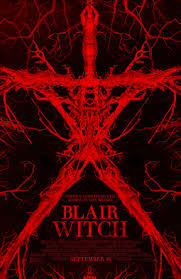
Blair Witch, a sequel to 1999's Blair Witch Project, is Simon Barrett's latest film.
Then came a brief but trenchant interview with criminologist Dr Bill Sanders. He dropped the bomb that horror films make murder too neat and tidy - in real life it's much messier. There was a lot more to explore here - I'd have liked to see a panel discussion with a few more guests.
The whole concept of The Core opens up new worlds of possibility for pastiche. In this episode the humour was occasionally less than sophisticated, but maybe that's unavoidable with gore. And who am I kidding? I was laughing.
An actual failing of the episode was that it featured not a single woman. I look forwards to seeing the Soska Sisters in a later episode but I hope they're not the final word on women in horror.
December 8, 2017
Twit Follows: @GraveyardSister
@GraveyardSister is the twitter feed for Graveyard Shift Sister, a website devoted to black women in horror and science fiction.
It was one of the first accounts I followed and I love it.
Twitter is all about coming across random things you'd not otherwise encounter and @GraveyardSister is no exception. Tweets link back to book and film reviews, interviews with authors and directors, the odd article by an academic, and they're always fascinating. Take this tweet for example:
Searching for Sycorax
— BW Horror Studies (@GraveyardSister) November 24, 2017
*Now Available for Pre-Order*https://t.co/JG25xYfvgN pic.twitter.com/peDiOpEg0C

Kinitra D. Brook, author of Searching for Sycorax: Black Women's Haunting of Contemporary Horror.
I'm sure I'm not alone in suspecting that horror is really about history coming back to haunt us (or trying and failing to do so). Black history is towering and this book which looks at African disaporic women writers in the genre looks really illuminating.
I also loved this tweet:
ICYMI: The Girl with All the Gifts & The Science Of Survival #SciFiSunday https://t.co/3hSYgFoyDJ
— BW Horror Studies (@GraveyardSister) November 12, 2017
It linked to a terrific blog on how empathy humanizes us - not the conclusion you would expect to be drawn from a zombie film.
At other times the feed talks about gaming, African folktales, or new subscription TV services. It also instigates chats about designated watching matter, which looks like fun (I'm in the wrong timezone).
I appreciate having my eyes opened to the experience of black women, and to new layers of the horror genre. Getting both in the same tweets is dreamy. If you're anything like me @GraveyardSister is an essential follow.
December 7, 2017
The Core episode 1 - FlyLo and Freaks
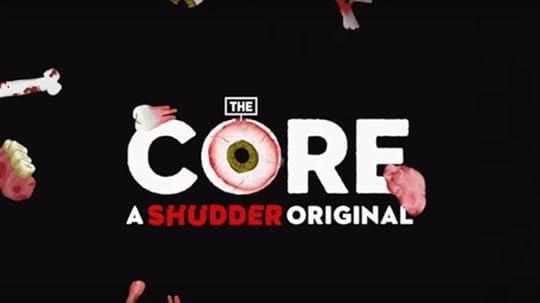
The Core, Shudder's new talkshow, feels a bit like a warm hug. If loving horror is an orientation, then here is a place to identify and relate.
The first episode features Steve Ellison aka Flying Lotus, the director of brilliant arty body-horror Kuso. He's more relaxed than I've ever seen him perhaps because of Core presenter Mickey Keating's obvious sympathy.
Vanilla interviewers will say things to Steve Ellison like:
"As balls to the wall bad taste as you could possible get,"
and:
"You've made one of the craziest movies I've ever seen."
Whereas Keating says:
"It's a gross-out movie, people were offended by it, but when you watch it it's got a lot of heart, it's got a lot of comedy."
He asks insider questions, like "How did you fall in with David Firth?" and "What's the reason film school fucked you up?"
The result is a hilarious and inspiring interview.
A regular feature on special effects is great. (FlyLo: "I like even doing funky textures on the walls, I was all throwin' some beans you saw on the walls back there, and that just has a nice look.")
The next interview, with Venice Beach Freakshow proprietor Todd Ray and two of his 'wonders', was unexpectedly touching. I found it uncomfortable at first, because Ray sat in front of Bubble Boy Bob Heslip and Bearded Lady Jessa Olmstead and did most of the talking. But once they did speak it was obvious the Venice Beach outfit is a million miles away from the exploitative freak shows of old and is forging a progressive discourse on difference and the body.
The Core, or at least this first episode, me feel really good about being a horror fan. The genre delves into the stuff society likes to ignore and yes, it's radical and shocking. But it's got heart.
December 6, 2017
Public Information Campaign - Alone at Last

The way the world would look if the Splits was out of control.
This is the infamous noughties 'Alone at Last' ad from the UK Splits Authority. It's drab and depressing - the situation at this time was dire and the message had to be strong. There were complaints, but it sure as hell worked. We're digging out similar examples from the 90s, 80s and 70s to complete the Archive.
December 5, 2017
Twit Follows: @PsychToday
Psychology Today's twitter feed is great for everybody - horror fans, writers, couples, single people, parents, depressives, manics, Donald Trump.... everybody.
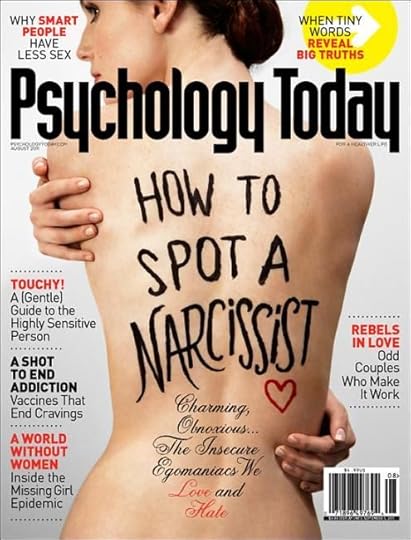
A classic Psychology Today front cover.
@PsychToday pumps out concise nuggets on deep human experiences almost hourly. You won't get a deep psychoanalytic exposition on the imaginary versus the symbolic. But you will get a simple, practical takeaway that you can apply to the book you're writing, your kids, your friendships, your relationship, or your own mood.
If you're that kind of horror fan, you can groove on how crazy and convoluted the human mind is. Plenty of the content is dark, covering death, sexual misdemeanours, anxiety, psychopaths and this:
Why your sweet little kitty cat is really a furry little killing machine https://t.co/J8jKXYueIJ
— Psychology Today (@PsychToday) December 2, 2017
December 4, 2017
The Splits zombies: Lupe Ferraz confronts Dr White
On November 9 some time in the 21st century, the controversial psychologist Lupe Ferraz inveigled herself into an event at Dr White's private home. Here's what happened.
Mindhunter
SPOILER-FREE!
I don't generally like serial killer dramas, but I love Mindhunter. Watching it is like drinking fine wine - it doesn't stun you with sadistic murders, it lets the subtle undertones of the psychopathic rise up slowly on your palette. It's a mature piece of storytelling.
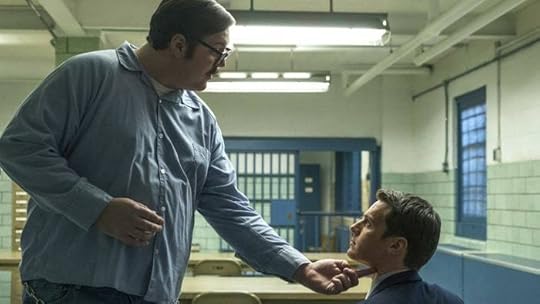
Cameron Britton as Ed Kemper opposite Jonathan Groff's Holden Ford. His performance made my living room feel colder.
Directed (mostly) by David Fincher and streamed on Netflix, Mindhunter is based on the real life development of criminal profiling by the FBI in the 1970s.
The story centres on a young FBI agent, Holden Ford (Jonathan Groff), who sees the potential for psychology to help catch "sequence killers", as he quaintly calls them. He starts working with a gruff agent from the FBI behavioural science unit, Bill Tench (Holt McCallany). Together they interview convicted killers about their motives, and apply what they've learned to solve difficult and disturbing murders around the US.
Many have pointed out how little violence there is in Mindhunter. It contains graphic crime scene photographs - I had to look away from some - but that's it.
Instead, the focus is on the bit of violent psychopathy that's really interesting - the inner world of the killer. Fincher repeats that extraordinary moment in Zodiac when we first meet suspect Arthur Leigh Allen (John Carroll Lynch). Allen has a strange otherworldly climate around him that sends chills out beyond the screen, and so do the convicts interviewed by Ford and Tench. These people don't even have to do anything to be dangerous - damage leaches out of their minds.
Next, the series examines the effect of these encounters on Ford and Tench. And that's when it gets really fascinating.
I gather serial killers are less frequent nowadays. But Mindhunter's sense of historical context is precisely what makes it relevant. This is driven home when Dr Wendy Carr, an academic exploring narcissism in the public sphere, joins the team. She mentions that Richard Nixon, Andy Warhol and Jim Morrison are among her subjects, and suddenly the neat edges of Mindhunter's ostensible topic blow down, revealing a much bigger picture.
The series knows that deviance is a spectrum, one healthy people share with serial killers. Serial killing may be in abeyance, but the inner world of the psychopath is something we all need to understand. It's in our environment - our workplaces, our communities, even our families. It's also, from time to time, quite possibly inside us.
Fine wine indeed.
December 3, 2017
Introducing Twit Follows
I'm going to start following twitter accounts in an ominious new way by reviewing them. Feeling creeped? Fabulous. Look behind you!
For Twit Follows, I'll review accounts that I follow already and want to follow in that extra special way because I think they're cool. I'll also review notable accounts that I've just discovered. It'll be mainly horror, but not exclusively.
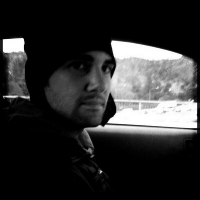
David Robert Mitchell, director of It Follows.
It seemed appropriate to start Twit Follows with @DRobMitchell - that's David Robert Mitchell, the director of 2014 masterpiece It Follows.
He's been quiet lately, hopefully because he's directing a new film. But he was active over summer and autumn, mainly retweets. His feed is a mix of stuff about his films, other people's films and Donald Trump.
Little gems that I haven't seen before (admittedly I did have a break from twitter) include:
My daughter and I visited 6 "It Follows" filming locations. Thanks for making such an amazing film @DRobMitchell pic.twitter.com/dgGI7GzIx9
— Jody Horror Guy (@JodyHorrorGuy) May 18, 2016
and:
AMERICAN HONEY meet-cute = Shia LaBeouf dancing to Rihanna's "We Found Love" on a Kmart checkout counter while holding a lint roller pic.twitter.com/GGu6PfOoBq
— A24 (@A24) October 7, 2016
and:
"They Live" Trump billboard spotted in Mexico City!



